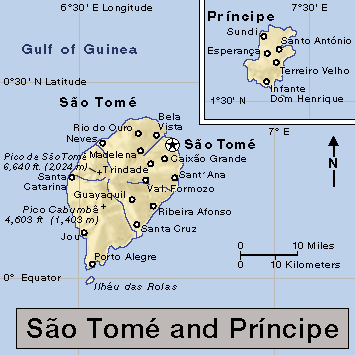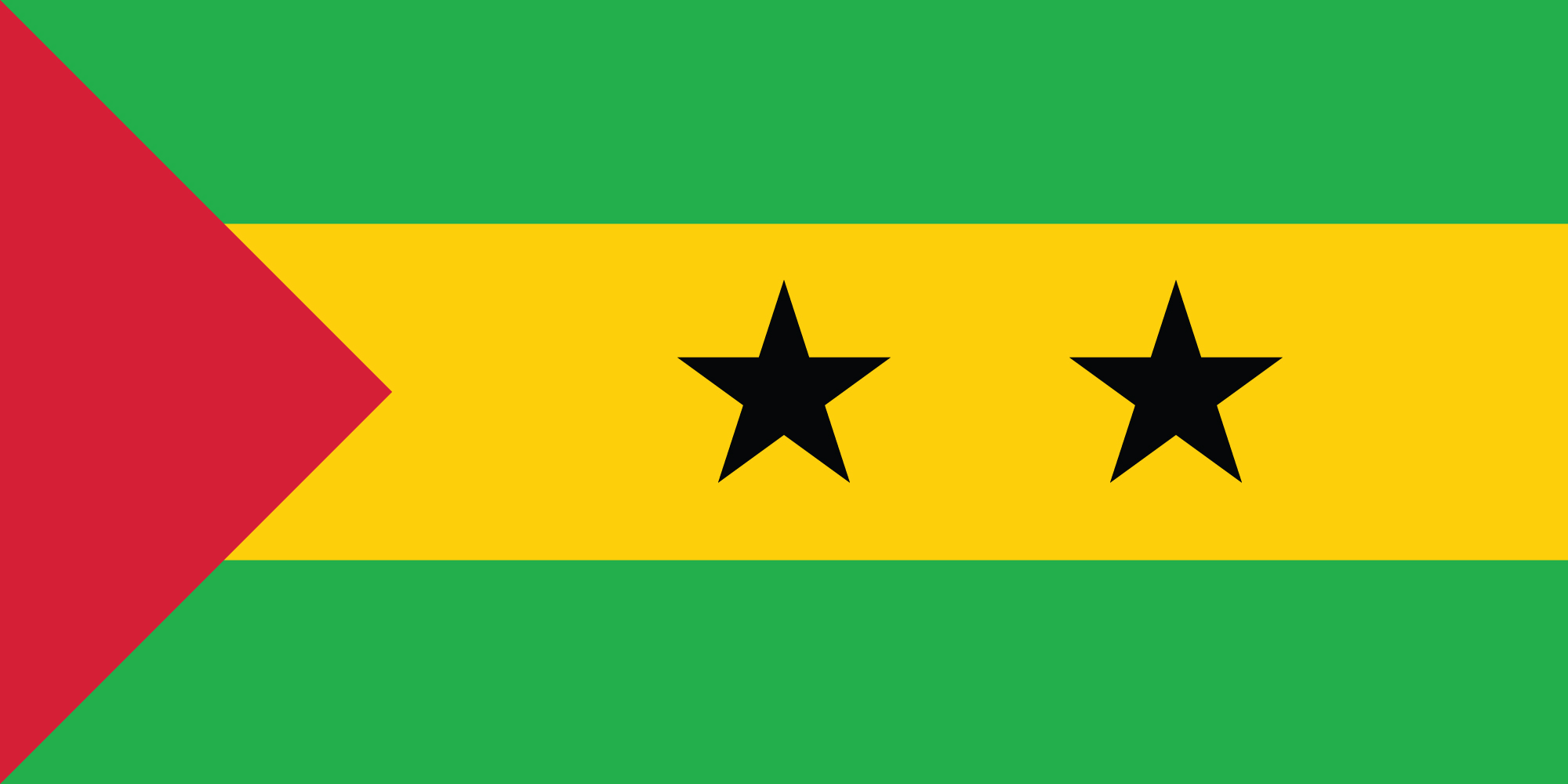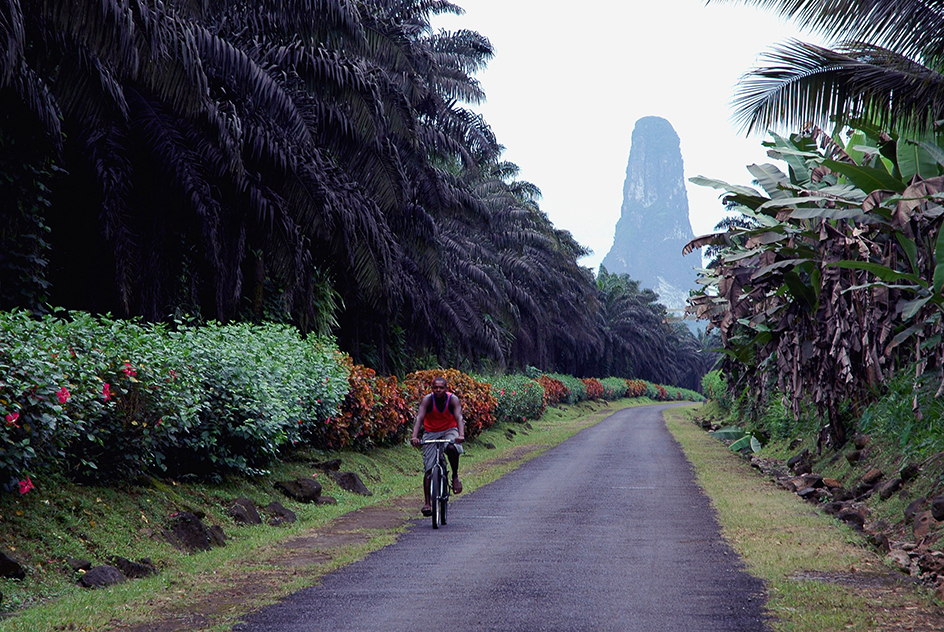São Tomé and Príncipe << SOWN taw MEH and PREEN see puh >> is an African country that consists of two main islands and several tiny islands. The main islands are São Tomé Island and Príncipe Island. The country lies in the Gulf of Guinea, about 180 miles (290 kilometers) west of Libreville, Gabon, on the African mainland.

São Tomé Island is much larger than Príncipe Island. It accounts for about 85 percent of the country’s area and has about 95 percent of its people. About one-fourth of the people in São Tomé and Príncipe live in rural areas and work on farms. The city of São Tomé, on São Tomé Island, is the nation’s capital and largest city. The city serves as a trading and shipping center for the country’s farm products.
São Tomé and Príncipe became an independent nation in 1975. It had been ruled by Portugal for most of the period since the late 1400’s. During the 1500’s, São Tomé Island became a center of the African and trans-Atlantic slave trade.
Government.
São Tomé and Príncipe is a republic. The people elect a president to a five-year term. The president is limited to two terms. The National Assembly makes the nation’s laws. The people elect its 55 members to four-year terms. A prime minister is chosen by the National Assembly and approved by the president. A cabinet, chosen by the prime minister and appointed by the president, helps run the government.

People.
About 70 percent of the people of São Tomé and Príncipe have mixed African and European ancestry. Sometimes called Creoles, they are considered the native people of the islands. Other residents come from the island country of Cabo Verde and the African mainland. A major group are the Angolars, descendants of Angolans who escaped from slavery in the 1500’s. Europeans account for a small percentage of the population.
Many Creoles own small farms or businesses, or work on fishing crews or as laborers. Some Europeans own farms, and others have jobs requiring technical or management skills. Most Africans from Cabo Verde and the mainland are laborers with low-paying jobs.
Portuguese is the most widely used language in São Tomé and Príncipe. Many Creoles and Europeans speak a dialect based on Portuguese as it was spoken hundreds of years ago. This dialect also includes words from several African languages. Roman Catholicism is the main religion among the Creoles and Europeans. Africans from Cabo Verde and the mainland use the language and practice the religion of their place of origin. By law, children in São Tomé and Príncipe are required to complete elementary school, but many do not do so. Relatively few children go on to high school.
Land and climate.
The islands of São Tomé and Príncipe are part of a series of extinct volcanoes. The western part of São Tomé Island rises sharply from the sea, and forests grow near the shore. Inland, formations of basalt rock rise steeply toward the center of the island. The land gradually slopes downward from the center to the north and east coasts. There, volcanic ash has formed deep deposits of fertile soil. Príncipe Island has a similar land pattern.

São Tomé and Príncipe islands lie a little north of the equator. The weather is hot and humid from September to May, and hot and dry from June to August. The average annual temperature varies from 77 °F (25 °C) in the lowlands to about 65 °F (18 °C) in the highlands. The annual rainfall averages 16 inches (41 centimeters).
Economy.
São Tomé and Príncipe is a poor country. The country’s economy is largely based on agriculture, though fishing is also important. São Tomé and Príncipe has little manufacturing or mining. The country relies heavily on foreign aid.
Farmers grow bananas, cacao, coconuts, palm oil and palm kernels, and taro. Chickens are raised for eggs and meat. Cacao is the country’s leading export. São Tomé and Príncipe does not grow enough food for its people, and it must import wheat and other food products. The country also imports machinery, petroleum products, and transportation equipment.
History.
Portuguese explorers discovered the islands of São Tomé and Príncipe in 1470, during the great age of Portuguese discovery. The islands were uninhabited at the time.
About 1485, Portugal began to send convicts, exiles, and settlers to the islands. These people tried to raise sugar, which was in great demand in Europe. But growing sugar requires much labor, and there were not enough people to produce large crops. The Portuguese then started to bring Africans from the mainland to work in slavery on the sugar plantations. The islands soon ranked among the world’s leading sugar producers.
In the mid-1500’s, many enslaved people on São Tomé Island revolted against the plantation owners. A number of owners abandoned their plantations, and sugar production declined. By then, many nations were involved in the African slave trade. São Tomé Island became a major center of it. Africans from the mainland were sent to São Tomé and then shipped to the Americas and elsewhere.
The Dutch ruled São Tomé Island from 1641 to 1648, and then the Portuguese regained control. In the 1800’s, Portuguese planters began to grow coffee and cocoa on the islands, using enslaved laborers to help raise these crops.
Portugal and most other nations ended slavery in the 1800’s. But the Portuguese continued to bring mainland Africans to São Tomé and Príncipe as contract laborers. These workers were treated harshly, and they revolted unsuccessfully from time to time during the 1800’s and 1900’s. In 1953, Portuguese troops killed hundreds of workers during a protest. This event is called the Batepa massacre.
In the mid-1900’s, some people began working toward an end to Portuguese rule in São Tomé and Príncipe. Demands for independence increased in 1974, and the islands gained independence on July 12, 1975. Since then, the country’s leaders have maintained strong relations with Portugal. São Tomé and Príncipe has received loans from Portugal for airport and road construction.
